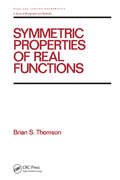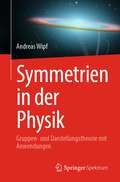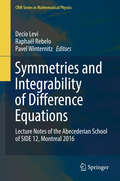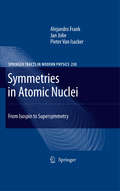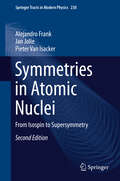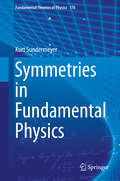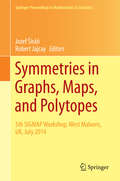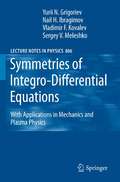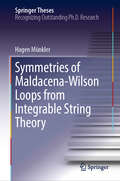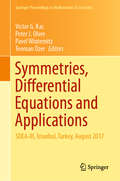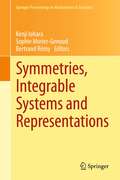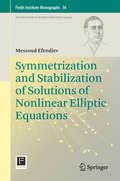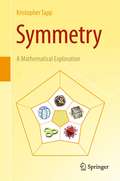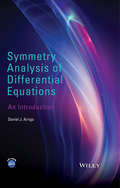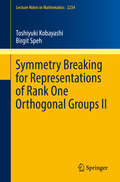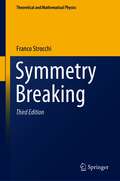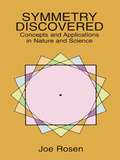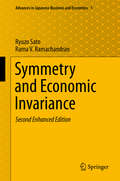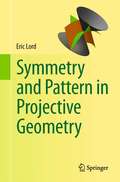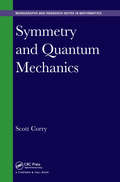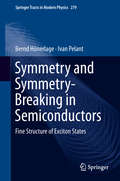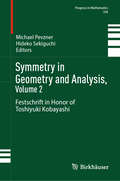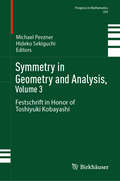- Table View
- List View
Symmetric Properties of Real Functions
by Brian thomsonThis work offers detailed coverage of every important aspect of symmetric structures in function of a single real variable, providing a historical perspective, proofs and useful methods for addressing problems. It provides assistance for real analysis problems involving symmetric derivatives, symmetric continuity and local symmetric structure of sets or functions.
Symmetrien in der Physik: Gruppen- und Darstellungstheorie mit Anwendungen
by Andreas WipfDas vorliegende Buch führt durch die Symmetrien in der Physik: Es werden wichtige Gruppen und Symmetrien aus der Molekülphysik, der Festkörperphysik und (Quanten-)Feldtheorie vorgestellt und behandelt. Das Buch richtet sich an Studierende der Physik, die entweder die Vorlesung zur Gruppen- und Darstellungstheorie hören oder sich im Rahmen einer Bachelor-, Master- oder Doktorarbeit in Gruppentheorie und Symmetrien in der Physik einlesen möchten. Behandelt werden u.a. endliche und kontinuierliche Gruppen sowie Lie-Algebren und deren Darstellungen, aber auch klassische und quantisierte Feldtheorien, Eichtheorien und konforme Feldtheorien. Der Autor verbindet in den Kapiteln die mathematischen Grundlagen mit der physikalischen Anwendung. Beispiele, Aufgaben und Zwischenfragen helfen Leserinnen und Lesern dabei, ihr Verständnis zu überprüfen..
Symmetries and Integrability of Difference Equations
by Decio Levi Raphaël Rebelo Pavel WinternitzDifference equations are playing an increasingly important role in the natural sciences. Indeed many phenomena are inherently discrete and are naturally described by difference equations. Phenomena described by differential equations are therefore approximations of more basic discrete ones. Moreover, in their study it is very often necessary to resort to numerical methods. This always involves a discretization of the differential equations involved, thus replacing them by difference equations. This book shows how Lie group and integrability techniques, originally developed for differential equations, have been adapted to the case of difference ones. Each of the eleven chapters is a self-contained treatment of a topic, containing introductory material as well as the latest research results. The book will be welcomed by graduate students and researchers seeking an introduction to the field. As a survey of the current state of the art it will also serve as a valuable reference.
Symmetries in Atomic Nuclei
by Pieter Van Isacker Jan Jolie Alejandro FrankSymmetries in Atomic Nuclei aims to present an overview of recent applications of symmetry to the description of atomic nuclei. Special care is given to a pedagogical introduction of symmetry concepts using simple examples. After a historical overview of the applications of symmetry in nuclear physics, progress in the field during the last decade is reviewed. Special emphasis is put on the introduction of neutron-proton and boson-fermion degrees of freedom. Their combination leads to a supersymmetric description of pairs and quartets of nuclei. Both theoretical aspects and experimental signatures of dynamical (super)symmetries are carefully discussed. Case studies show how these symmetries are displayed by real atomic nuclei which have been studied experimentally using state-of-the art spectroscopy. This book focuses on nuclear structure physics and has been written by active investigators in the field, but its scope is wider and is intended for final-year or post-graduate students and researchers interested in understanding the power and beauty of symmetry methods in physics.
Symmetries in Atomic Nuclei: From Isospin to Supersymmetry (Springer Tracts in Modern Physics #230)
by Jan Jolie Alejandro Frank Pieter Van IsackerThe revised edition of this established work presents an extended overview of recent applications of symmetry to the description of atomic nuclei, including a pedagogical introduction to symmetry concepts using simple examples. Following a historical overview of the applications of symmetry in nuclear physics, attention turns to more recent progress in the field. Special emphasis is placed on the introduction of neutron-proton and boson-fermion degrees of freedom. Their combination leads to a supersymmetric description of pairs and quartets of nuclei. Expanded and updated throughout, the book now features separate chapters on the nuclear shell model and the interacting boson model, the former including discussion of recent results on seniority in a single-j shell. Both theoretical aspects and experimental signatures of dynamical (super)symmetries are carefully discussed. This book focuses on nuclear structure physics, but its broad scope makes it suitable for final-year or post-graduate students and researchers interested in understanding the power and beauty of symmetry methods in physics.Review of the 1st Edition:"The subject of this book, symmetries in physical systems, with particular focus on atomic nuclei, is of the utmost importance in modern physical science. In contrast to most treatments, frequently characterized by fearsome formalism, this book leads the reader step-by-step, in an easily understandable way, through this fascinating field...this book is remarkably accessible to both theorists and experimentalists. Indeed, I view it as essential reading for experimental nuclear structure physicists. This is one of the finest volumes on this subject I have ever encountered." Prof. R.F. Casten, Yale University
Symmetries in Fundamental Physics (Fundamental Theories of Physics #176)
by Kurt SundermeyerOver the course of the last century it has become clear that both elementary particle physics and relativity theories are based on the notion of symmetries. These symmetries become manifest in that the "laws of nature" are invariant under spacetime transformations and/or gauge transformations. The consequences of these symmetries were analyzed as early as in 1918 by Emmy Noether on the level of action functionals. Her work did not receive due recognition for nearly half a century, but can today be understood as a recurring theme in classical mechanics, electrodynamics and special relativity, Yang-Mills type quantum field theories, and in general relativity. As a matter of fact, as shown in this monograph, many aspects of physics can be derived solely from symmetry considerations. This substantiates the statement of E.P.Wigner "... if we knew all the laws of nature, or the ultimate Law of nature, the invariance properties of these laws would not furnish us new information." Thanks to Wigner we now also understand the implications of quantum physics and symmetry considerations: Poincare invariance dictates both the characteristic properties of particles (mass, spin, ...) and the wave equations of spin 0, 1/2, 1, ... objects. Further, the work of C.N.Yang and R.Mills reveals the consequences of internal symmetries as exemplified in the symmetry group of elementary particle physics. Given this pivotal role of symmetries it is thus not surprising that current research in fundamental physics is to a great degree motivated and inspired by considerations of symmetry.The treatment of symmetries in this monograph ranges from classical physics to now well-established theories of fundamental interactions, to the latest research on unified theories and quantum gravity.
Symmetries in Graphs, Maps, and Polytopes
by Jozef Širáň Robert JajcayThis volume contains seventeen of the best papers delivered at the SIGMAP Workshop 2014, representing the most recent advances in the field of symmetries of discrete objects and structures, with a particular emphasis on connections between maps, Riemann surfaces and dessins d'enfant. Providing the global community of researchers in the field with the opportunity to gather, converse and present their newest findings and advances, the Symmetries In Graphs, Maps, and Polytopes Workshop 2014 was the fifth in a series of workshops. The initial workshop, organized by Steve Wilson in Flagstaff, Arizona, in 1998, was followed in 2002 and 2006 by two meetings held in Aveiro, Portugal, organized by Antonio Breda d'Azevedo, and a fourth workshop held in Oaxaca, Mexico, organized by Isabel Hubard in 2010. This book should appeal to both specialists and those seeking a broad overview of what is happening in the area of symmetries of discrete objects and structures. iv>
Symmetries of Integro-Differential Equations: With Applications in Mechanics and Plasma Physics
by N. Kh. Ibragimov Sergey V. Meleshko Yurii N. Grigoriev Vladimir F. KovalevThis book aims to coherently present applications of group analysis to integro-differential equations in an accessible way. The book will be useful to both physicists and mathematicians interested in general methods to investigate nonlinear problems using symmetries. Differential and integro-differential equations, especially nonlinear, present the most effective way for describing complex processes. Therefore, methods to obtain exact solutions of differential equations play an important role in physics, applied mathematics and mechanics. This book provides an easy to follow, but comprehensive, description of the application of group analysis to integro-differential equations. The book is primarily designed to present both fundamental theoretical and algorithmic aspects of these methods. It introduces new applications and extensions of the group analysis method. The authors have designed a flexible text for postgraduate courses spanning a variety of topics.
Symmetries of Maldacena-Wilson Loops from Integrable String Theory (Springer Theses)
by Hagen MünklerThe book discusses hidden symmetries in the Anti-de Sitter/conformal field theory (AdS/CFT) duality. This duality is a modern concept that asserts an exact duality between conformally invariant quantum field theories and string theories in higher dimensional Anti-de Sitter spaces, and in this way provides a completely new tool for the study of strongly coupled quantum field theories. In this setting, the book focuses on the Wilson loop, an important observable in four-dimensional maximally supersymmetric gauge theory. The dual string description using minimal surfaces enables a systematic study of the hidden symmetries of the loop. The book presents major findings, including the discovery of a master symmetry for strings in general symmetric spaces, its relation to the Yangian symmetry algebra and its action on the minimal surfaces appearing in the dual string description of the Wilson loop. Moreover, it clarifies why certain symmetries are not present on the gauge theory side for purely bosonic Wilson loops and, lastly, how the supersymmetrization of the minimal surface problem for type IIB superstrings can be undertaken. As such, it substantially increases our understanding and use of infinite dimensional symmetries occurring in the AdS/CFT correspondence.
Symmetries, Differential Equations and Applications: Sdea-iii, Istanbul, Turkey, January 2017 (Springer Proceedings in Mathematics & Statistics #266)
by Pavel Winternitz Peter J. Olver Victor G. Kac Teoman ÖzerBased on the third International Conference on Symmetries, Differential Equations and Applications (SDEA-III), this proceedings volume highlights recent important advances and trends in the applications of Lie groups, including a broad area of topics in interdisciplinary studies, ranging from mathematical physics to financial mathematics. The selected and peer-reviewed contributions gathered here cover Lie theory and symmetry methods in differential equations, Lie algebras and Lie pseudogroups, super-symmetry and super-integrability, representation theory of Lie algebras, classification problems, conservation laws, and geometrical methods. The SDEA III, held in honour of the Centenary of Noether’s Theorem, proven by the prominent German mathematician Emmy Noether, at Istanbul Technical University in August 2017 provided a productive forum for academic researchers, both junior and senior, and students to discuss and share the latest developments in the theory and applications of Lie symmetry groups. This work has an interdisciplinary appeal and will be a valuable read for researchers in mathematics, mechanics, physics, engineering, medicine and finance.
Symmetries, Integrable Systems and Representations
by Sophie Morier-Genoud Kenji Iohara Bertrand RémyThis volume is the result of two international workshops; Infinite Analysis 11 - Frontier of Integrability - held at University of Tokyo, Japan in July 25th to 29th, 2011, and Symmetries, Integrable Systems and Representations held at Université Claude Bernard Lyon 1, France in December 13th to 16th, 2011. Included are research articles based on the talks presented at the workshops, latest results obtained thereafter, and some review articles. The subjects discussed range across diverse areas such as algebraic geometry, combinatorics, differential equations, integrable systems, representation theory, solvable lattice models and special functions. Through these topics, the reader will find some recent developments in the field of mathematical physics and their interactions with several other domains.
Symmetrization and Stabilization of Solutions of Nonlinear Elliptic Equations (Fields Institute Monographs #36)
by Messoud EfendievThis book deals with a systematic study of a dynamical system approach to investigate the symmetrization and stabilization properties of nonnegative solutions of nonlinear elliptic problems in asymptotically symmetric unbounded domains. The usage of infinite dimensional dynamical systems methods for elliptic problems in unbounded domains as well as finite dimensional reduction of their dynamics requires new ideas and tools. To this end, both a trajectory dynamical systems approach and new Liouville type results for the solutions of some class of elliptic equations are used. The work also uses symmetry and monotonicity results for nonnegative solutions in order to characterize an asymptotic profile of solutions and compares a pure elliptic partial differential equations approach and a dynamical systems approach. The new results obtained will be particularly useful for mathematical biologists.
Symmetrization in Analysis (New Mathematical Monographs #36)
by Albert Baernstein IISymmetrization is a rich area of mathematical analysis whose history reaches back to antiquity. This book presents many aspects of the theory, including symmetric decreasing rearrangement and circular and Steiner symmetrization in Euclidean spaces, spheres and hyperbolic spaces. Many energies, frequencies, capacities, eigenvalues, perimeters and function norms are shown to either decrease or increase under symmetrization. The book begins by focusing on Euclidean space, building up from two-point polarization with respect to hyperplanes. Background material in geometric measure theory and analysis is carefully developed, yielding self-contained proofs of all the major theorems. This leads to the analysis of functions defined on spheres and hyperbolic spaces, and then to convolutions, multiple integrals and hypercontractivity of the Poisson semigroup. The author's 'star function' method, which preserves subharmonicity, is developed with applications to semilinear PDEs. The book concludes with a thorough self-contained account of the star function's role in complex analysis, covering value distribution theory, conformal mapping and the hyperbolic metric.
Symmetry
by Kristopher TappThis textbook is perfect for a math course for non-math majors, with the goal of encouraging effective analytical thinking and exposing students to elegant mathematical ideas. It includes many topics commonly found in sampler courses, like Platonic solids, Euler's formula, irrational numbers, countable sets, permutations, and a proof of the Pythagorean Theorem. All of these topics serve a single compelling goal: understanding the mathematical patterns underlying the symmetry that we observe in the physical world around us. The exposition is engaging, precise and rigorous. The theorems are visually motivated with intuitive proofs appropriate for the intended audience. Students from all majors will enjoy the many beautiful topics herein, and will come to better appreciate the powerful cumulative nature of mathematics as these topics are woven together into a single fascinating story about the ways in which objects can be symmetric.
Symmetry Analysis of Differential Equations
by Daniel J. ArrigoA self-contained introduction to the methods and techniques of symmetry analysis used to solve ODEs and PDEsSymmetry Analysis of Differential Equations: An Introduction presents an accessible approach to the uses of symmetry methods in solving both ordinary differential equations (ODEs) and partial differential equations (PDEs). Providing comprehensive coverage, the book fills a gap in the literature by discussing elementary symmetry concepts and invariance, including methods for reducing the complexity of ODEs and PDEs in an effort to solve the associated problems. Thoroughly class-tested, the author presents classical methods in a systematic, logical, and well-balanced manner. As the book progresses, the chapters graduate from elementary symmetries and the invariance of algebraic equations, to ODEs and PDEs, followed by coverage of the nonclassical method and compatibility. Symmetry Analysis of Differential Equations: An Introduction also features:Detailed, step-by-step examples to guide readers through the methods of symmetry analysisEnd-of-chapter exercises, varying from elementary to advanced, with select solutions to aid in the calculation of the presented algorithmic methodsSymmetry Analysis of Differential Equations: An Introduction is an ideal textbook for upper-undergraduate and graduate-level courses in symmetry methods and applied mathematics. The book is also a useful reference for professionals in science, physics, and engineering, as well as anyone wishing to learn about the use of symmetry methods in solving differential equations.
Symmetry Breaking for Representations of Rank One Orthogonal Groups II (Lecture Notes in Mathematics #2234)
by Toshiyuki Kobayashi Birgit Speh<p>This work provides the first classification theory of matrix-valued symmetry breaking operators from principal series representations of a reductive group to those of its subgroup. <p>The study of symmetry breaking operators (intertwining operators for restriction) is an important and very active research area in modern representation theory, which also interacts with various fields in mathematics and theoretical physics ranging from number theory to differential geometry and quantum mechanics. <p>The first author initiated a program of the general study of symmetry breaking operators. The present book pursues the program by introducing new ideas and techniques, giving a systematic and detailed treatment in the case of orthogonal groups of real rank one, which will serve as models for further research in other settings. <p>In connection to automorphic forms, this work includes a proof for a multiplicity conjecture by Gross and Prasad for tempered principal series representations in the case (SO(n + 1, 1), SO(n, 1)). The authors propose a further multiplicity conjecture for nontempered representations. <p>Viewed from differential geometry, this seminal work accomplishes the classification of all conformally covariant operators transforming differential forms on a Riemanniann manifold X to those on a submanifold in the model space (X, Y) = (Sn, Sn-1). Functional equations and explicit formulæ of these operators are also established. <p>This book offers a self-contained and inspiring introduction to the analysis of symmetry breaking operators for infinite-dimensional representations of reductive Lie groups. This feature will be helpful for active scientists and accessible to graduate students and young researchers in representation theory, automorphic forms, differential geometry, and theoretical physics.</p>
Symmetry Breaking: A Non-perturbative Outlook (Theoretical and Mathematical Physics #732)
by Franco StrocchiThe third edition of the by now classic reference on rigorous analysis of symmetry breaking in both classical and quantum field theories adds new topics of relevance, in particular the effect of dynamical Coulomb delocalization, by which boundary conditions give rise to volume effects and to energy/mass gap in the Goldstone spectrum (plasmon spectrum, Anderson superconductivity, Higgs phenomenon). The book closes with a discussion of the physical meaning of global and local gauge symmetries and their breaking, with attention to the effect of gauge group topology in QCD. From the reviews of the first edition: It is remarkable to see how much material can actually be presented in a rigorous way (incidentally, many of the results presented are due to Strocchi himself), yet this is largely ignored, the original heuristic derivations being, as a rule, more popular. - At each step he strongly emphasizes the physical meaning and motivation of the various notions introduced [...] a book that fills a conspicuous gap in the literature, and does it rather well. It could also be a good basis for a graduate course in mathematical physics. J.-P. Antoine, Physicalia 28/2, 2006 Despite many accounts in popular textbooks and a widespread belief, the phenomenon is rather subtle, requires an infinite set of degrees of freedom and an advanced mathematical setting of the system under investigation. [...] The mathematically oriented graduate student will certainly benefit from this thorough, rigorous and detailed investigation. G. Roepstorff, Zentralblatt MATH, Vol. 1075, 2006 From the reviews of the second edition: This second edition of Strocchi’s Symmetry Breaking presents a complete, generalized and highly rigorous discussion of the subject, based on a formal analysis of conditions necessary for the mechanism of spontaneous symmetry breaking to occur in classical systems, as well as in quantum systems. […] This book is specifically recommended for mathematical physicists interested in a deeper and rigorous understanding of the subject, and it should be mandatory for researchers studying the mechanism of spontaneous symmetry breaking. S. Hajjawi, Mathematical Reviews, 2008
Symmetry Discovered: Concepts and Applications in Nature and Science
by Joe RosenSymmetry provides an insight into the way nature works and is often used by scientists and technologists to help solve problems. Symmetry has numerous other applications as well -- with more being discovered all the time in science, the arts and other fields of human endeavor.This classic work provides an excellent introduction to the basic concepts and terminology (including, optionally, group theory), as well as lucid discussions of geometric symmetry, other symmetries and appropriate symmetry, symmetry in nature, uses of symmetry in science and much more.Readers wishing to pursue specific topics will find many references that reflect the author's wide reading in the subject and his own obvious enthusiasm. For this edition, Dr. Rosen has provided a new preface, solutions to the problems, and an addendum to the bibliography.
Symmetry and Economic Invariance
by Ryuzo Sato Rama V. RamachandranSymmetry and Economic Invariance (second enhanced edition) explores how the symmetry and invariance of economic models can provide insights into their properties. Although the professional economist of today is adept at many of the mathematical techniques used in static and dynamic optimization models, group theory is still not among his or her repertoire of tools. The authors aim to show that group theoretic methods form a natural extension of the techniques commonly used in economics and that they can be easily mastered. Part I provides an introduction that minimizes prerequisites including prior knowledge of group theory. Part II discusses recent developments in the field.
Symmetry and Pattern in Projective Geometry
by Eric LordSymmetry and Pattern in Projective Geometry is a self-contained study of projective geometry which compares and contrasts the analytic and axiomatic methods. The analytic approach is based on homogeneous coordinates, and brief introductions to Plücker coordinates and Grassmann coordinates are presented. This book looks carefully at linear, quadratic, cubic and quartic figures in two, three and higher dimensions. It deals at length with the extensions and consequences of basic theorems such as those of Pappus and Desargues. The emphasis throughout is on special configurations that have particularly interesting symmetry properties. The intricate and novel ideas of 'Donald' Coxeter, who is considered one of the great geometers of the twentieth century, are also discussed throughout the text. The book concludes with a useful analysis of finite geometries and a description of some of the remarkable configurations discovered by Coxeter. This book will be appreciated by mathematics students and those wishing to learn more about the subject of geometry. It makes accessible subjects and theorems which are often considered quite complicated and presents them in an easy-to-read and enjoyable manner.
Symmetry and Quantum Mechanics (Chapman & Hall/CRC Monographs and Research Notes in Mathematics)
by Scott CorryStructured as a dialogue between a mathematician and a physicist, Symmetry and Quantum Mechanics unites the mathematical topics of this field into a compelling and physically-motivated narrative that focuses on the central role of symmetry. Aimed at advanced undergraduate and beginning graduate students in mathematics with only a minimal background in physics, this title is also useful to physicists seeking a mathematical introduction to the subject. Part I focuses on spin, and covers such topics as Lie groups and algebras, while part II offers an account of position and momentum in the context of the representation theory of the Heisenberg group, along the way providing an informal discussion of fundamental concepts from analysis such as self-adjoint operators on Hilbert space and the Stone-von Neumann Theorem. Mathematical theory is applied to physical examples such as spin-precession in a magnetic field, the harmonic oscillator, the infinite spherical well, and the hydrogen atom.
Symmetry and Symmetry-Breaking in Semiconductors: Fine Structure of Exciton States (Springer Tracts in Modern Physics #279)
by Bernd Hönerlage Ivan PelantThis book discusses group theory investigations of zincblende and wurtzite semiconductors under symmetry-breaking conditions. The text presents the group theory elements required to develop a multitude of symmetry-breaking problems, giving scientists a fast track to bypass the need for recalculating electronic states. The text is not only a valuable resource for speeding up calculations but also illustrates the construction of effective Hamiltonians for a chosen set of electronic states in crystalline semiconductors. Since Hamiltonians have to be invariant under the transformations of the point group, the crystal symmetry determines the multiplet structure of these states in the presence of spin-orbit, crystal-field, or exchange interactions. Symmetry-breaking leads to additional coupling of the states, resulting in shifts and/or splittings of the multiplets. Such interactions may be intrinsic, as in the case of the quasi-particle dispersion, or extrinsic, induced by magnetic, electric, or strain fields. Using a power expansion of the perturbations these interaction terms can be determined in their parameterized form in a unique way. The hierarchic structure of this invariant development allows to estimate the importance of particular symmetry-breaking effects in the Hamiltonian. A number of selected experimental curves are included to illustrate the symmetry-based discussions, which are especially important in optical spectroscopy. This text is written for graduate students and researchers who want to understand and simulate experimental findings reflecting the fine structure of electronic or excitonic states in crystalline semiconductors.
Symmetry in Geometry and Analysis, Volume 2: Festschrift in Honor of Toshiyuki Kobayashi (Progress in Mathematics #358)
by Michael Pevzner Hideko SekiguchiSymmetry in Geometry and Analysis is a Festschrift honoring Toshiyuki Kobayashi. The three volumes feature 35 selected contributions from invited speakers of twin conferences held in June 2022 in Reims, France, and in September 2022 in Tokyo, Japan. These contributions highlight the profound impact of Prof. Kobayashi’s pioneering ideas, groundbreaking discoveries, and significant achievements in the development of analytic representation theory, noncommutative harmonic analysis, and the geometry of discontinuous groups beyond the Riemannian context, among other areas, over the past four decades. This second volume of the Festschrift contains original articles on analytic methods in representation theory of reductive Lie groups and related topics. Contributions are by Salem Ben Saïd, Valentina Casarino, Paolo Ciatti, Jean-Louis Clerc, Jan Frahm, Joachim Hilgert, Toshihisa Kubo, Khalid Koufany, Quentin Labriet, Karl-Hermann Neeb, Yury Neretin, Gestur Ólafsson, Bent Ørsted, Toshio Oshima, Birgit Speh, Jorge Vargas, and Clemens Weiske.
Symmetry in Geometry and Analysis, Volume 3: Festschrift in Honor of Toshiyuki Kobayashi (Progress in Mathematics #359)
by Michael Pevzner Hideko SekiguchiSymmetry in Geometry and Analysis is a Festschrift honoring Toshiyuki Kobayashi. The three volumes feature 35 selected contributions from invited speakers of twin conferences held in June 2022 in Reims, France, and in September 2022 in Tokyo, Japan. These contributions highlight the profound impact of Prof. Kobayashi’s pioneering ideas, groundbreaking discoveries, and significant achievements in the development of analytic representation theory, noncommutative harmonic analysis, and the geometry of discontinuous groups beyond the Riemannian context, among other areas, over the past four decades. This third volume of the Festschrift contains original articles on branching problems in representation theory of reductive Lie groups and related topics. Contributions are by Ali Baklouti, Hidenori Fujiwara, Dmitry Gourevitch, Masatoshi Kitagawa, Salma Nasrin, Yoshiki Oshima, and Petr Somberg.
Symmetry in Inorganic and Coordination Compounds: A Student's Guide to Understanding Electronic Structure (Lecture Notes in Chemistry #106)
by Franca MorazzoniThis book addresses the nature of the chemical bond in inorganic and coordination compounds. In particular, it explains how general symmetry rules can describe chemical bond of simple inorganic molecules. Since the complexity of studying even simple molecules requires approximate methods, this book introduces a quantum mechanical treatment taking into account the geometric peculiarities of the chemical compound. In the case of inorganic molecules, a convenient approximation comes from symmetry, which constrains both the electronic energies and the chemical bonds. The book also gives special emphasis on symmetry rules and compares the use of symmetry operators with that of Hamiltonian operators. Where possible, the reactivity of molecules is also rationalized in terms of these symmetry properties. As practical examples, electronic spectroscopy and magnetism give experimental confirmation of the predicted electronic energy levels.Adapted from university lecture course notes, this book is the ideal companion for any inorganic chemistry course dealing with group theory.
